| Listing 1 - 10 of 34 | << page >> |
Sort by
|
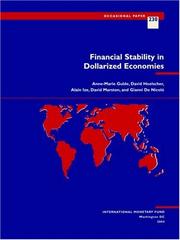

ISBN: 1589062965 1462396607 1452797757 9781589062962 Year: 2004 Volume: 230 Publisher: Washington, D.C. : International Monetary Fund,
Abstract | Keywords | Export | Availability | Bookmark
 Loading...
Loading...Choose an application
- Reference Manager
- EndNote
- RefWorks (Direct export to RefWorks)
This paper addresses the challenges to prudential supervision in highly dollarized economies, where central banks and supervisors may be constrained in the use of standard money and financial policy tools. The study’s conclusions are the basis of an ongoing policy dialogue with IMF member countries, standard-setters in the financial area, and academia. The paper is part of the policy development work conducted by the IMF’s Monetary and Financial Systems Department.
Money. Monetary policy --- Dollar, American --- Monetary policy --- Banks and banking --- Banks and banking. --- Dollar, American. --- Monetary policy. --- 330.05 --- 332.46 --- Monetary management --- Economic policy --- Currency boards --- Money supply --- Agricultural banks --- Banking --- Banking industry --- Commercial banks --- Depository institutions --- Finance --- Financial institutions --- Money --- American dollar --- Banks and Banking --- Finance: General --- Financial Risk Management --- Foreign Exchange --- Money and Monetary Policy --- Monetary Systems --- Standards --- Regimes --- Government and the Monetary System --- Payment Systems --- Banks --- Depository Institutions --- Micro Finance Institutions --- Mortgages --- Financial Institutions and Services: Government Policy and Regulation --- Monetary Policy --- Monetary economics --- Currency --- Foreign exchange --- Financial services law & regulation --- Currencies --- Bank deposits --- Dollarization --- Exchange rates --- Financial services --- Real exchange rates --- State supervision --- Argentina
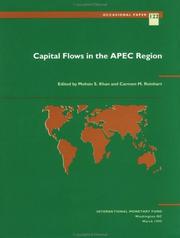
ISBN: 1557754667 1462339093 1452717699 Year: 1995 Publisher: Washington, D.C. : International Monetary Fund,
Abstract | Keywords | Export | Availability | Bookmark
 Loading...
Loading...Choose an application
- Reference Manager
- EndNote
- RefWorks (Direct export to RefWorks)
The developing economies of the Asia Pacific Economic Cooperation (APEC) have been the recipients of a considerable volume of capital inflows in the 1990s. Given the increased integration of capital markets, it is not surprising that monetary control became more difficult for many developing APEC economies. Formulating an appropriate policy response has naturally been important. The three papers that make up this Occasional Paper each examine different aspects of these issues.
International finance --- Asia --- Capital movements --- mouvements internationaux des capitaux --- fmi --- apec --- azie --- -Capital movements --- -330.05 --- 332.042 --- Capital flight --- Capital flows --- Capital inflow --- Capital outflow --- Flight of capital --- Flow of capital --- Movements of capital --- Balance of payments --- Foreign exchange --- internationaal kapitaalverkeer --- imf --- asie --- 330.05 --- Banks and Banking --- Exports and Imports --- Finance: General --- Investments: Bonds --- Investments: Stocks --- International Investment --- Long-term Capital Movements --- General Financial Markets: General (includes Measurement and Data) --- Banks --- Depository Institutions --- Micro Finance Institutions --- Mortgages --- Pension Funds --- Non-bank Financial Institutions --- Financial Instruments --- Institutional Investors --- Foreign Exchange --- International economics --- Investment & securities --- Banking --- Finance --- Currency --- Capital inflows --- Stock markets --- Commercial banks --- Bonds --- Financial markets --- Financial institutions --- Banks and banking --- Stock exchanges --- Stocks --- Hong Kong Special Administrative Region, People's Republic of China

ISBN: 1589062213 1462322948 1452790353 9781589062214 Year: 2003 Volume: 220 Publisher: Washington, D.C. : International Monetary Fund,
Abstract | Keywords | Export | Availability | Bookmark
 Loading...
Loading...Choose an application
- Reference Manager
- EndNote
- RefWorks (Direct export to RefWorks)
This study provides a candid, systematic, and critical review of recent evidence on this complex subject. Based on a review of the literature and some new empirical evidence, it finds that (1) in spite of an apparently strong theoretical presumption, it is difficult to detect a strong and robust causal relationship between financial integration and economic growth; (2) contrary to theoretical predictions, financial integration appears to be associated with increases in consumption volatility (both in absolute terms and relative to income volatility) in many developing countries; and (3) there appear to be threshold effects in both of these relationships, which may be related to absorptive capacity. Some recent evidence suggests that sound macroeconomic frameworks and, in particular, good governance are both quantitatively and qualitatively important in affecting developing countries’ experiences with financial globalization.
Finance --- Globalization --- 339 --- 336.71 --- -Globalization --- -Developing Countries. --- croissance economique --- globalisation --- investissements --- pays en voie de developpement --- 330.05 --- Global cities --- Globalisation --- Internationalization --- International relations --- Anti-globalization movement --- Funding --- Funds --- Economics --- Currency question --- Handel. Internationale economische betrekkingen. Wereldeconomie --binnenlandse als buitenlandse handel; zie ook {339.3} en {339.5} --- Bankwezen --- economische groei --- globalisering --- investeringen --- ontwikkelingslanden --- Globalización. --- Países en desarrollo. --- 336.71 Bankwezen --- 339 Handel. Internationale economische betrekkingen. Wereldeconomie --binnenlandse als buitenlandse handel; zie ook {339.3} en {339.5} --- Globalización. --- Países en desarrollo. --- Finance - Developing countries --- Globalization - Developing countries --- Exports and Imports --- Finance: General --- Financial Risk Management --- Macroeconomics --- International Investment --- Long-term Capital Movements --- General Financial Markets: General (includes Measurement and Data) --- Macroeconomics: Consumption --- Saving --- Wealth --- Globalization: General --- Financial Crises --- Current Account Adjustment --- Short-term Capital Movements --- International economics --- Economic & financial crises & disasters --- Financial integration --- Capital flows --- Foreign direct investment --- Consumption --- Financial markets --- Balance of payments --- National accounts --- Capital movements --- International finance --- Investments, Foreign --- United States

ISBN: 0792318498 9401048118 9401118388 Year: 1993 Publisher: Zaventem : Kluwer,
Abstract | Keywords | Export | Availability | Bookmark
 Loading...
Loading...Choose an application
- Reference Manager
- EndNote
- RefWorks (Direct export to RefWorks)
One of the key issues relating to the perfonnance of national economies is the efficiency of the financial system which stands at the heart of the capital-allocation process. There are two aspects which define efficiency. Static efficiency involves the ali-in difference between rates of return provided to ultimate savers and the cost of funds to users. This 'gap', or spread, reflects the direct costs of production (operating and administrative costs, cost of capital, etc.). It also reflects losses incurred in the financial process, as well as any monopoly profits earned and liquidity premiums. Financial processes that are considered 'statically inefficient' are usually characterised by high 'spreads' due to high overhead costs, high losses, barriers to entry, and the like. Dynamic efficiency is characterised by high rates of financial product and process innovation through time. Successful product and process innovation broadens the menu of financial products available to ultimate issuers, ultimate savers, or other agents along the various financial process channels described above. Probably the most powerful catalyst affecting the competitive dynamics of the financial services industry has been technological change.
339.7 <4>
---
339.92

ISBN: 1557756686 146234111X 1452792712 9781557756688 Year: 1997 Volume: 151 Publisher: Washington, D.C. : International Monetary Fund,
Abstract | Keywords | Export | Availability | Bookmark
 Loading...
Loading...Choose an application
- Reference Manager
- EndNote
- RefWorks (Direct export to RefWorks)
This paper provides a comprehensive analysis of the attractions and disadvantages of currency board arrangements in their various institutional configurations. It asks what defines a currency board arrangement, what are their strengths and weaknesses, and what constraints they place on macroeconomic policies. It also reviews country experiences with these arrangements.
Money. Monetary policy --- Currency boards --- Foreign exchange administration --- -Monetary policy --- Foreign exchange --- 336.74 --- monetair beleid --- institutions monetaires internationales --- politique monetaire --- commerce mondial --- marche international des capitaux --- taux de change --- AA* / International - Internationaal --- 333.825 --- 333.480 --- 331.32 --- 333.450 --- 333.451.1 --- 330.05 --- 332.414 --- Cambistry --- Currency exchange --- Exchange, Foreign --- Foreign currency --- Foreign exchange problem --- Foreign money --- Forex --- FX (Finance) --- International exchange --- International finance --- Currency crises --- Monetary management --- Economic policy --- Money supply --- Financial institutions --- Monetary policy --- Cost effectiveness --- Geld. Geldwezen. Monetaire sector. --- internationale monetaire instellingen --- wereldhandel --- internationale kapitaalmarkt --- wisselkoers --- Deviezenpolitiek. Interventies. --- Geldstelsel. --- Structuur van de economie. --- Theorie van het deviezenverkeer. Theorie van de koopkrachtpariteit. --- Wisselkoersen. --- Working papers --- Currency boards. --- Foreign exchange administration. --- Money. --- 336.74 Geld. Geldwezen. Monetaire sector. --- Money --- Currency --- Monetary question --- Money, Primitive --- Specie --- Standard of value --- Exchange --- Finance --- Value --- Banks and banking --- Coinage --- Currency question --- Gold --- Silver --- Silver question --- Wealth --- Structuur van de economie --- Theorie van het deviezenverkeer. Theorie van de koopkrachtpariteit --- Wisselkoersen --- Geldstelsel --- Deviezenpolitiek. Interventies --- Geld. Geldwezen. Monetaire sector --- Banks and Banking --- Finance: General --- Foreign Exchange --- Inflation --- Money and Monetary Policy --- Public Finance --- Banks --- Depository Institutions --- Micro Finance Institutions --- Mortgages --- Monetary Systems --- Standards --- Regimes --- Government and the Monetary System --- Payment Systems --- Monetary Policy --- Interest Rates: Determination, Term Structure, and Effects --- Price Level --- Deflation --- Banking --- Monetary economics --- Macroeconomics --- Economic & financial crises & disasters --- Public finance & taxation --- Exchange rates --- Currencies --- International reserves --- Commercial banks --- Central banks --- Exchange rate arrangements --- Foreign exchange reserves --- Interest rates --- Prices --- Hong Kong Special Administrative Region, People's Republic of China
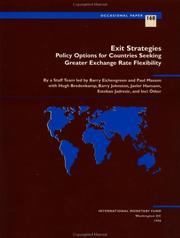

ISBN: 1557757348 1462331025 1452740909 9781557757340 Year: 1998 Volume: 168 Publisher: Washington, D.C. : International Monetary Fund,
Abstract | Keywords | Export | Availability | Bookmark
 Loading...
Loading...Choose an application
- Reference Manager
- EndNote
- RefWorks (Direct export to RefWorks)
In a world of increasing capital mobility and broadening and more diversified trade, many (but not all) developing and transition economies are likely to find it desirable to move from relatively fixed exchange rate regimes to regimes of greater exchange rate flexibility. This paper suggests why, and considers strategies that countries may consider for such a move. It reinforces this discussion with a review of experience from teh past two decades with alternative exchange rate regimes. The paper also identifies policies that can facilitate the transition to greater exchange rate flexibility for countries that wish to pursue this option.
International finance --- Developing countries --- Monetary policy --- Fiscal policy --- Foreign exchange rates --- 339.74 <1-773> --- 336.74 <1-773> --- -Foreign exchange rates --- -Monetary policy --- -monetair beleid --- ontwikkelingslanden --- wisselkoersbeleid --- chili --- israel --- mexico --- polen --- AA* / International - Internationaal --- 333.451.6 --- 333.451.1 --- 330.05 --- 332.456 --- Monetary management --- Economic policy --- Currency boards --- Money supply --- Exchange rates --- Fixed exchange rates --- Flexible exchange rates --- Floating exchange rates --- Fluctuating exchange rates --- Foreign exchange --- Rates of exchange --- Tax policy --- Taxation --- Finance, Public --- Monetaire buitenlandse politiek. Deviezenpolitiek--Gebieden in ontwikkeling. Ontwikkelingslanden --- Geld. Geldwezen. Monetaire sector.--Gebieden in ontwikkeling. Ontwikkelingslanden --- politique de taux de change --- mexique --- pologne --- Vlottende wisselkoersen. Crawling peg. --- Wisselkoersen. --- Rates --- Government policy --- Working papers --- 336.74 <1-773> Geld. Geldwezen. Monetaire sector.--Gebieden in ontwikkeling. Ontwikkelingslanden --- 339.74 <1-773> Monetaire buitenlandse politiek. Deviezenpolitiek--Gebieden in ontwikkeling. Ontwikkelingslanden --- monetair beleid --- Wisselkoersen --- Vlottende wisselkoersen. Crawling peg --- Foreign exchange rates. --- Monetary policy. --- Fiscal policy. --- Monetary policy - Developing countries --- Fiscal policy - Developing countries --- Foreign exchange rates - Developing countries --- Banks and Banking --- Exports and Imports --- Finance: General --- Foreign Exchange --- Money and Monetary Policy --- Monetary Systems --- Standards --- Regimes --- Government and the Monetary System --- Payment Systems --- International Investment --- Long-term Capital Movements --- Development Planning and Policy: Trade Policy --- Factor Movement --- Foreign Exchange Policy --- International Financial Markets --- Currency --- Monetary economics --- International economics --- Finance --- Financial services law & regulation --- Exchange rate arrangements --- Exchange rate flexibility --- Currencies --- Conventional peg --- Money --- Capital movements --- Foreign exchange market --- Financial risk management --- United States
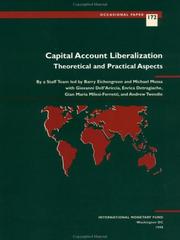
ISBN: 1557757771 1462302777 1452775214 9781557757777 Year: 1998 Volume: 172 Publisher: Washington, D.C. : International Monetary Fund,
Abstract | Keywords | Export | Availability | Bookmark
 Loading...
Loading...Choose an application
- Reference Manager
- EndNote
- RefWorks (Direct export to RefWorks)
Capital account liberalization - orderly, properly sequence, and befitting the individual circumstances of countries- is an inevitable step for all countries wishing to realize the benefits of the globalized economy. This paper reviews the theories behind capital account liberalization and examines the dangers associated with free capital flows. The authors conclude that the dangers can be limited through a combination of sound macroeconomic and prudential policies.
International finance --- Capital movements --- 339.72 --- financiën --- markteconomie --- monetair beleid --- mouvements internationaux des capitaux --- economie de marche libre --- AA* / International - Internationaal --- 333.602 --- 382.242.0 --- 333.454.0 --- 382.20 --- 330.05 --- 332.46 --- Capital flight --- Capital flows --- Capital inflow --- Capital outflow --- Flight of capital --- Flow of capital --- Movements of capital --- Balance of payments --- Foreign exchange --- Internationaal betalingsverkeer. Valutahandel. Wisselmarkten. Deviezenhandel. Internationale kapitaalmarkt. Flow and funds analysis. Betalingsbalans. Internationale geldmarkt. --- internationaal kapitaalverkeer --- vrije markteconomie --- Activiteiten en evolutie van de financiële markten. --- Balans van het kapitaalverkeer: algemeenheden. --- Deviezencontrole: algemeenheden. --- Internationale betalingen en betalingsbalans: algemeenheden. --- Working papers --- 339.72 Internationaal betalingsverkeer. Valutahandel. Wisselmarkten. Deviezenhandel. Internationale kapitaalmarkt. Flow and funds analysis. Betalingsbalans. Internationale geldmarkt. --- Deviezencontrole: algemeenheden --- Activiteiten en evolutie van de financiële markten --- Internationale betalingen en betalingsbalans: algemeenheden --- Balans van het kapitaalverkeer: algemeenheden --- Internationaal betalingsverkeer. Valutahandel. Wisselmarkten. Deviezenhandel. Internationale kapitaalmarkt. Flow and funds analysis. Betalingsbalans. Internationale geldmarkt --- Capital movements. --- Banks and Banking --- Exports and Imports --- Finance: General --- Money and Monetary Policy --- Industries: Financial Services --- Financial Risk Management --- Current Account Adjustment --- Short-term Capital Movements --- International Investment --- Long-term Capital Movements --- Banks --- Depository Institutions --- Micro Finance Institutions --- Mortgages --- General Financial Markets: Government Policy and Regulation --- Monetary Systems --- Standards --- Regimes --- Government and the Monetary System --- Payment Systems --- International economics --- Finance --- Banking --- Monetary economics --- Economic & financial crises & disasters --- Capital account liberalization --- Capital account --- Capital controls --- Commercial banks --- Financial institutions --- Banks and banking --- Investments, Foreign --- Financial services industry --- Foreign exchange market --- United States
Book
ISBN: 1589060474 1462317901 1452752001 9781589060470 Year: 2001 Volume: 207 Publisher: Washington, D.C. : International Monetary Fund,
Abstract | Keywords | Export | Availability | Bookmark
 Loading...
Loading...Choose an application
- Reference Manager
- EndNote
- RefWorks (Direct export to RefWorks)
This paper discusses how Malaysia can better protect itself from future shocks and avoid another crisis while it seeks to regain its position as one of the fastest growing economies in the world. To these ends, its strategy should include continued structural reforms to achieve healthy balance sheets of the banking and corporate sectors; further deregulation to promote competition and efficiency; and consistent macroeconomic policies to maintain financial stability and sustainable fiscal and external positions. Malaysia's economic structure and performance were relatively strong prior to the crisis. Malaysia’s initial low level of short-term external debt enabled it to maintain foreign reserves at a reasonably high level, and this contributed to relatively robust external and domestic confidence early on in the crisis. As a consequence of financial vigilance exercised through prudential regulation of capital movements, the exposure of the financial and corporate systems was contained. Stock market capitalization in Malaysia grew to an extremely high level prior to the crisis, reflecting both the fast expansion of the capital market and liberal capital account regime.
Economic policy and planning (general) --- Malaysia --- monetair beleid --- ontwikkelingsplan --- ontwikkelingsbeleid --- 338 <595.11> --- asie --- financement --- politique fiscale --- politique monetaire --- societes --- structure economique --- Fiscal policy --- -Finance --- -MY / Malaysia - Maleisië - Malaisie --- 331.31 --- 330.05 --- 330.9595 --- Funding --- Funds --- Economics --- Currency question --- Tax policy --- Taxation --- Economic policy --- Finance, Public --- Economische situatie. Economische structuur van bepaalde landen en gebieden. Economische geografie. Economische produktie.economische produkten. Economische diensten--Maleisië --- azie --- financiering --- fiscaal beleid --- vennootschappen --- economische structuur --- Economisch beleid. --- Government policy --- Economic conditions. --- Economic policy. --- Working papers --- Economisch beleid: Maleisië --- Economische landenstudies: Maleisië --- Fiscaal beleid: Maleisië --- Economisch beleid: Maleisië. --- Economische landenstudies: Maleisië. --- Fiscaal beleid: Maleisië. --- 338 <595.11> Economische situatie. Economische structuur van bepaalde landen en gebieden. Economische geografie. Economische produktie.economische produkten. Economische diensten--Maleisië --- Economisch beleid --- -Malaysia --- Banks and Banking --- Corporate Finance --- Exports and Imports --- Public Finance --- Industries: Financial Services --- Finance: General --- Banks --- Depository Institutions --- Micro Finance Institutions --- Mortgages --- International Investment --- Long-term Capital Movements --- Fiscal Policy --- Corporate Finance and Governance: General --- Macroeconomics: Production --- Finance --- Macroeconomics --- Banking --- Ownership & organization of enterprises --- International economics --- Monetary economics --- Corporate sector --- Capital controls --- Nonperforming loans --- Financial institutions --- Balance of payments --- Economic sectors --- Corporate governance --- Banks and banking --- Business enterprises --- Capital movements --- Loans --- Production --- Economic theory
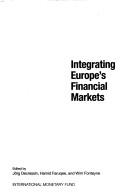
ISBN: 9781589066236 1589066235 1462388574 9786613847096 145279474X 1451931751 1283534649 9781451931754 Year: 2007 Publisher: [Washington, D.C.]
Abstract | Keywords | Export | Availability | Bookmark
 Loading...
Loading...Choose an application
- Reference Manager
- EndNote
- RefWorks (Direct export to RefWorks)
By and large, EU financial integration has been a success story. Still, the reform agenda is far from finished. What are the remaining challenges? What are the gains of closer financial market integration? This IMF book tracks the European Union's journey along the path to a single financial market and identifies the challenges and priorities that remain ahead. It pays particular attention to the most recent integration efforts in the European Union following the introduction of the euro. The study looks at the importance of financial integration, in particular for economic growth, the interplay between banks and markets, and equity market integration. It closely examines the relationship between financial integration and financial stability. This interaction presents the European Union with a challenge, but also with the opportunity to play a pioneering role in developing a regional approach to financial stability that could provide lessons for the rest of the world.
Private finance --- Europe --- Finance --- Capital market --- Financial institutions --- Finances --- Marché financier --- Institutions financières --- European Union --- Economic integration. --- Business & Economics --- Economic History --- 339.7 --- eenheidsmarkt --- europa --- financiele markten --- 333.102 --- 333.602 --- 333.610 --- 334.151.28 --- EEC / European Union - EU -Europese Unie - Union Européenne - UE --- -Finance --- -332.094 --- Financial intermediaries --- Lending institutions --- Associations, institutions, etc. --- Funding --- Funds --- Economics --- Currency question --- Internationale financien. Buitenlands betalingsverkeer --(z.o {336}) --- marché unique --- europe --- marchés financiers --- Bankconcentratie. --- Activiteiten en evolutie van de financiële markten. --- Effectenbeurzen: algemeenheden. --- Kredietinstellingen in de Europese Gemeenschappen. --- 339.7 Internationale financien. Buitenlands betalingsverkeer --(z.o {336}) --- Marché financier --- Institutions financières --- Capital markets --- Market, Capital --- E.U. --- Loans --- Money market --- Securities --- Crowding out (Economics) --- Efficient market theory --- 332.094 --- Bankconcentratie --- Activiteiten en evolutie van de financiële markten --- Effectenbeurzen: algemeenheden --- Kredietinstellingen in de Europese Gemeenschappen --- European Union countries --- Banks and Banking --- Finance: General --- Financial Risk Management --- Investments: Stocks --- Industries: Financial Services --- Accounting --- Investments: General --- Insurance --- General Financial Markets: General (includes Measurement and Data) --- Banks --- Depository Institutions --- Micro Finance Institutions --- Mortgages --- General Financial Markets: Government Policy and Regulation --- Financial Institutions and Services: Government Policy and Regulation --- Pension Funds --- Non-bank Financial Institutions --- Financial Instruments --- Institutional Investors --- Bankruptcy --- Liquidation --- Banking --- Investment & securities --- Economic & financial crises & disasters --- Insurance & actuarial studies --- Macroeconomics --- Financial reporting, financial statements --- Stock markets --- Financial sector stability --- Financial integration --- Financial services --- Financial markets --- Financial sector policy and analysis --- Competition --- Banks and banking --- Financial services industry --- Stock exchanges --- International finance --- United States
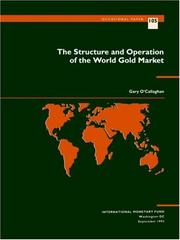
ISBN: 1557752818 1462307825 1452777225 Year: 1993 Publisher: Washington, D.C. : International Monetary Fund,
Abstract | Keywords | Export | Availability | Bookmark
 Loading...
Loading...Choose an application
- Reference Manager
- EndNote
- RefWorks (Direct export to RefWorks)
This paper describes the structure of the world gold market, its sources of supply and demand, and how it functions. The paper examines the composition and origin of physical stocks of gold, their flows, and their market destination and also reviews the operation of bullion and paper gold markets.
International finance --- 336.743 --- 671.11 --- Gold --- -339.722 --- --- or --- international --- commerce --- AA* / International - Internationaal --- 382.242.0 --- 338.751.27 --- 333.452.1 --- 338.2741 --- 330.05 --- Specie --- Native element minerals --- Precious metals --- Transition metals --- Money --- Muntstandaard. Gouden standaard. Zilveren standaard. Bimetallisme --- Gold and silver articles. Engraved and embossed articles --- Purchasing --- goud --- internationaal --- handel --- Balans van het kapitaalverkeer: algemeenheden. --- Goud : metaal. --- Goudmarkt. --- Working papers --- Gold. --- Purchasing. --- 671.11 Gold and silver articles. Engraved and embossed articles --- 336.743 Muntstandaard. Gouden standaard. Zilveren standaard. Bimetallisme --- 339.722 --- Goudmarkt --- Goud : metaal --- Balans van het kapitaalverkeer: algemeenheden --- Banks and Banking --- Investments: Metals --- Exports and Imports --- Finance: General --- Investments: Futures --- Investments: Options --- Metals and Metal Products --- Cement --- Glass --- Ceramics --- General Financial Markets: General (includes Measurement and Data) --- Pension Funds --- Non-bank Financial Institutions --- Financial Instruments --- Institutional Investors --- Monetary Policy --- Trade: General --- Investment & securities --- Finance --- Banking --- International economics --- Macroeconomics --- Commodity markets --- Futures --- Gold reserves --- Options --- Commodities --- Financial markets --- Financial institutions --- Central banks --- Commodity exchanges --- Derivative securities --- Foreign exchange reserves --- Balance of payments --- United Kingdom
| Listing 1 - 10 of 34 | << page >> |
Sort by
|

 Search
Search Feedback
Feedback About
About Help
Help News
News